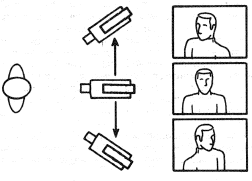Motivated Camera Movement
Ideally, there should be a good artistic reason behind everything you do during a production. Don’t just vary the shot for the sake of visual variety or to relieve the monotony.
Motivation
Whenever you make a change of any kind, that the audience does not want, or cannot understand, you have every prospect of frustrating them! If while watching someone demonstrating how to fit an accessory, you cut away to a closeup of their face,or pull out to a long shot, the viewer will resent the change.
•A camera move can arise:naturally — zooming in as the speaker points out details.
•Or you can deliberately create motivation. The seated speaker gets up to fetch a book to show to camera. The move looks natural enough,but it allows the director to activate an otherwise static shot.
• You can contrive business, having someone sit, alter their position, turn, put down an object, as a ‘reason’ to change the camera viewpoint
If there is too little movement in the subject or camera, interest falls. But excessive camera movement looks restless and fidgety. During a static scent, even a single move can become dramatic. But too many moves, and the impact of each is reduced.
Panning
Panning should be a smooth, deliberate, continuous operation. It’s wise to avoid panning over a wide-arc, e.g. between people some distance apart, it’s far better to cut between them. Very-fast pans are best reserved for startling effects (whip, zip, or swish
Changing the viewpoint
Static, shoulder-level shots form the core of TV studio presentation.But we often want to change this viewpoint Let us consider why we move.
• Moving in to the subject (dolly or track in, zoom in). We move in to see more detail; to concentrate attention; to exclude extraneous subjects; to identify detail; to: alter scale; to follow-a sybject as it moves away.
• Moving out from thesubject. (dolly or track back; zoom out). We move out to accommodate wider action; to show a subject’s relationship to its surround-ings; to take in more subjects; to reveal the reason for a person’s move; to follow someone moving away from the camera; to broaden information (from a soio singer to an entire choir); as an act of conclusion to action.
• Moving across the scene, (truck, crab). Here we follow transverse subject movement; or survey, a broad, long, spread-out subject; or a succession of subjects.
• Moving round the subject (arcing). Moving round a subject we can alter our scenic viewpoint; show different aspects of the subject and its surroundings; create visual variety; change the centre of interest; or recompose the shot to alter emphasis.
• Moving to a higher viewpoint (ped up, elevate, boom or crane up). High-angle shots can provide overall views; enable us to see over obstacles; or obtain level shots of tall or elevated subjects.
• Lower camera viewpoints (ped down, depress, boom or crane down). Very low positions give dramatic upward-looking shots, while low-level shots (ground shots, floor shots) give head-on views of ground level subjects.
Camera height
When the camera looks down, the subject tends to appear inferior,subdued Looking upwards, it seems dominant, powerful.

Arcing movement
As the camera moves round, a subject can appear to turn.

Trucking (crabbing) movement
As the camera moves across the scene, it obtains a more-oblique view of the subject.

